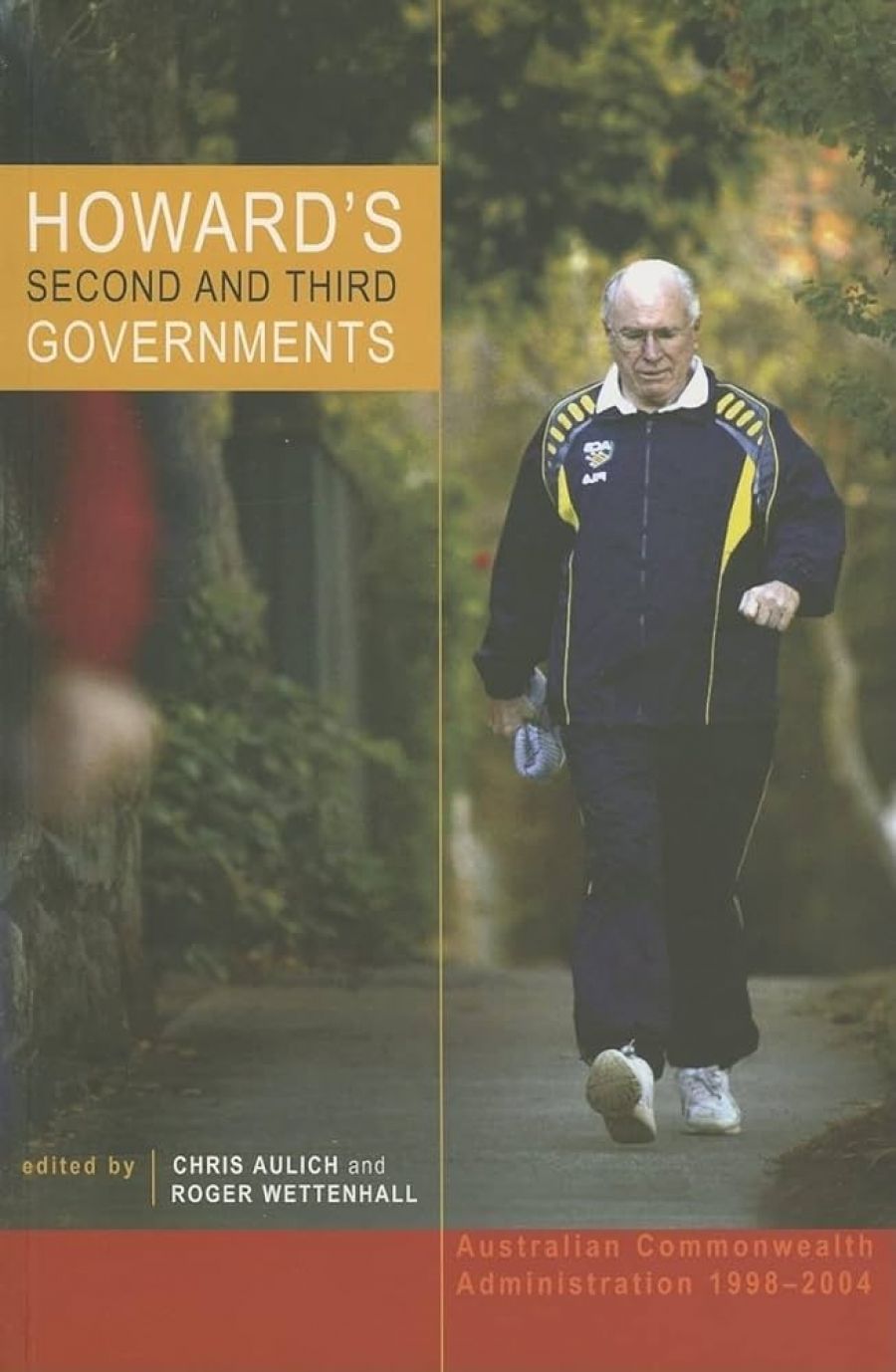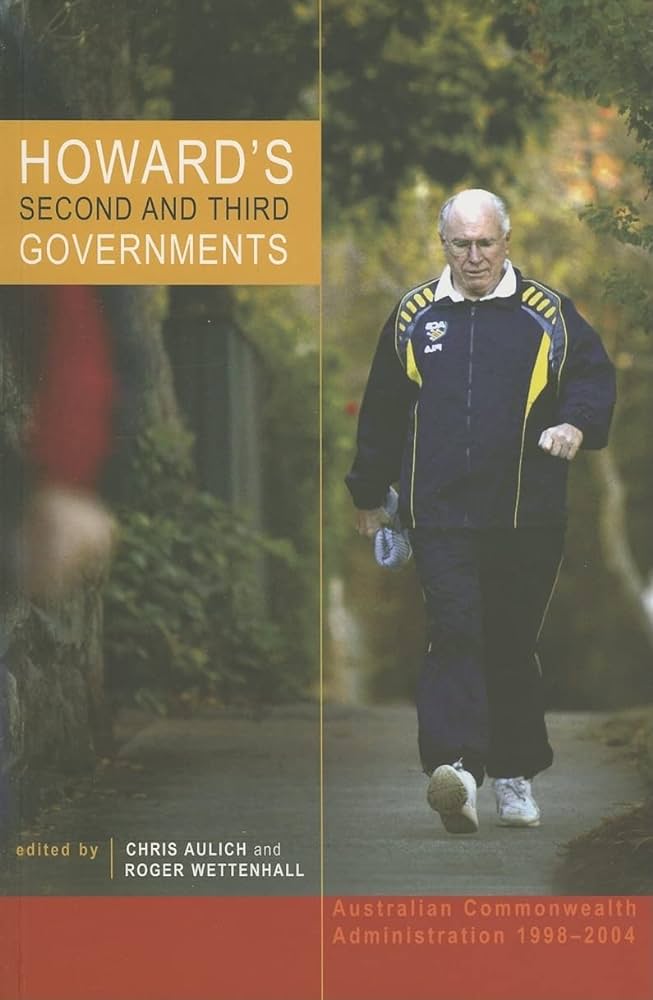
- Free Article: No
- Contents Category: Politics
- Review Article: Yes
- Article Title: A blander shade of grey
- Online Only: No
- Custom Highlight Text:
A flurry of books have been produced about the cultural aspects of John Howard’s governments: for example, Andrew Markus’s Race: John Howard and the Remaking of Australia (2001), Stuart Macintyre and Anna Clark’s The History Wars (2003) and Carol Johnson’s Governing Change: From Keating to Howard (2000). Useful edited collections have also been produced on each of the elections of 1996, 1998 and 2001, and on the republic referendum. In 2004 Robert Manne published an edited collection called The Howard Years, which was wider ranging than the cultural agenda, but generally critical in its tenor. But nine years since Howard defeated Paul Keating, there is still not a great deal of analysis.
- Book 1 Title: Howard's Second and Third Governments
- Book 1 Subtitle: Australian Commonwealth Administration 1998–2004
- Book 1 Biblio: UNSW Press, $39.95 pb, 269 pp
- Book 1 Cover Small (400 x 600):

- Book 1 Cover (800 x 1200):

Right-wing commentators are prone to see this as the fault of the left, some sort of conspiracy of inattention to rob Howard and his governments of their place in the history books; and they contrast it with the much greater volume of writing the Hawke–Keating period had generated after the same length of time in government. Here is a book to placate them.
It is on the second and third Howard governments, and is eighth in a series on the history of Australian Commonwealth Administration produced by a group of Canberra-based public administration scholars. The series began with the first Hawke government in 1983 and includes an earlier volume on the first Howard government, edited by Gwynneth Singleton (2000), and also published by UNSW. Its distinctive aim is to cover developments in public administration and the structures of governance, as well as some of the key policy areas. So it includes chapters on public sector reform, privatisation and outsourcing, and non-departmental public bodies. Somewhat allaying fears about the fate of the public service under Howard, John Halligan argues that after the rather heavy-handed reform of the public service in the first term, by the third a more reflective approach had developed and the public service was being reinvigorated. A chapter on federalism would have been welcome here, as the Howard governments have departed from the Liberal party’s commitment to states rights and become as centralising as any Labor government.
Harry Evans, Clerk of the Senate, contributes an excellent chapter on the relations between the government and the parliament. In the first volume, he had noted that, frustrated by their lack of control of the Senate, the government seemed to be exploring ways of drawing the Senate’s teeth, either by altering the electoral system or the conditions governing joint sittings. In the third term, after the 2001 election, the Department of Prime Minister and Cabinet produced a discussion paper with drastic suggestions about altering the constitutional balance between the Senate and the House of Representatives. Public reception was cool, and there was no chance the recommendations would survive a referendum, but it shows just how much irritation was building in the government about the Senate. Evans also notes that as the governments have gone on they have become less cooperative about the provision of information for Senate enquiries. In the 1996–98 term, there were forty-seven orders for information and only four failures to comply; in the 2001–04 parliament, there were eighty-four orders and thirty-seven failures.
The policies and issues covered are highly selective, and the chapters very uneven. There is nothing on health policy, the media and telecommunications, or industrial relations reform. Instead of an overall look at economic policy, there is a rather narrow chapter on tax policy. The best policy chapters are Will Sanders’s on indigenous affairs, which he titles ‘Never Even Adequate’, and James Jupp’s lucid and well-informed chapter on immigration and multiculturalism. Philip Mendes has a chapter on welfare reform and mutual obligations, which argues that the Howard government’s social welfare policies have been dominated by two ideological tendencies: a neo-liberal belief that social security payments should be restricted in the interests of the freedom of the market; and the social conservative concern to reinforce the traditional institutions such as the family, albeit both moderated by Howard’s electoral pragmatism.
This seems to me a somewhat ideological reading of social security under Howard, one that focuses on the rhetoric rather than the outcomes of policy, and is perhaps the result of discussing social policy independent of tax and labour market policy. Recent work by Anne Harding, from the National Centre for Economic and Social Modelling, has found that the Howard governments have in fact overseen a generally progressive transfer of income and services from the rich to the poor.
David Adams completes the volume with a very confused and unsatisfactory chapter on John Howard’s leadership, subtitled ‘The Enigma Variations’. Adams makes much of what a mysterious and difficult man Howard is to know. He presents eight variations, including, to my astonishment, one that is called Judith Brett’s John Howard. The chapter concludes: ‘[Howard] has been many things as Prime Minister: believer, pragmatist, conservative, reformer, hardcase, a man of emotion. The one thing he has not been is simple. To paint his portrait we need a palette containing a dazzling array of greys.’
A chapter that can’t do better than that would have been better left out.


Comments powered by CComment